Overview
We recognize the transformative impact of medical automation systems for healthcare providers. These systems not only enhance patient care but also significantly reduce costs and improve operational efficiency. With compelling evidence, we highlight how automation facilitates superior data management, ensures compliance, and optimizes resource allocation. As a result, we drive innovation and elevate overall healthcare delivery.
What’s holding your team back from embracing this change? By integrating these systems, we can unlock a future where healthcare is not only more efficient but also more effective. Join us in this journey towards a smarter healthcare landscape.
Introduction
In the dynamic realm of healthcare, we recognize that the integration of advanced automation systems is revolutionizing how we deliver care and manage operations. By focusing on enhancing patient outcomes and streamlining processes, platforms like Avato’s hybrid integration technology are dismantling silos and promoting seamless communication across diverse healthcare systems.
As we navigate the complexities of modern demands, leveraging real-time data and automated solutions is essential for improving operational efficiency, ensuring compliance, and ultimately enhancing the patient experience.
What’s holding your team back from embracing these transformative solutions? This article explores the multifaceted benefits of automation in healthcare, examining its impact on patient engagement, resource management, and innovation in service delivery.
Avato: Enhanced System Integration for Seamless Operations
At Avato, we transform the linking of diverse medical systems through our hybrid connection platform, enhancing the use of medical automation systems to promote smooth data flow and communication essential for contemporary medical providers. This integration dismantles operational silos, enhances data accessibility, and significantly improves patient outcomes. By utilizing our advanced technology, medical organizations can ensure their systems collaborate effectively, leading to superior care coordination and optimized resource management.
We are dedicated to architecting the technology foundations required to power rich, connected customer experiences. In an ever-evolving medical landscape, adaptability is key to survival. Our hybrid unification platform illustrates this flexibility, enabling medical providers to manage large volumes of data with enhanced visibility and efficiency. This capability underscores the significance of hybrid consolidation platforms in providing real-time analytics and infrastructure management, particularly in sectors such as banking and medical services.
Moreover, we ensure 24/7 availability for essential connections, guaranteeing that medical systems remain functional and attentive at all times. This reliability is paramount in environments where timely access to information can directly impact patient care. Our platform also offers real-time monitoring and alerts on system performance, significantly reducing costs and enhancing operational efficiency. As Gustavo Estrada, Acting Provincial Director, Performance & Transformation at BC Provincial Health Services Authority, aptly stated, “Avato has the ability to simplify complex projects and deliver results within desired time frames and budget constraints,” reflecting our platform’s effectiveness in managing the complexities of health system coordination.
The landscape of medical system unification is continually evolving, with an increasing focus on utilizing hybrid connection platforms to enhance operational capabilities. The integration of medical automation systems not only streamlines processes but also plays a crucial role in improving outcomes for individuals, making it an essential component of contemporary medical management. What’s holding your team back from achieving these advancements? Let us help you navigate this complexity and unlock the potential of your medical systems.
Improved Patient Care and Treatment Accuracy
Medical automation systems in the medical field significantly enhance care for individuals by providing medical professionals with precise and prompt information. Consider the impact of automated reminders for medication and appointments; they have been shown to improve adherence to treatment plans, thereby minimizing errors and enhancing outcomes for individuals. A recent MGMA Stat poll conducted on February 26, 2019, with 1,475 applicable responses, revealed that medical organizations implementing medical automation systems for automated reminders reported a notable increase in adherence rates, underscoring the effectiveness of these medical automation systems.
Furthermore, medical automation systems provide integrated automated solutions that facilitate real-time updates on conditions, empowering providers to make informed decisions swiftly. This capability is crucial in scenarios such as telemedicine and remote monitoring, where timely interventions can prevent complications and reduce unnecessary hospital visits. Case studies, including ‘Telemedicine and Remote Monitoring,’ illustrate that medical automation systems not only streamline scheduling and diagnostics but also enhance the overall accuracy of treatment plans.
As the relationship between humans and machines evolves, we increasingly recognize the value of medical automation systems in improving treatment accuracy. The advancements in digital medicine, particularly through AI and VR, are humanizing care by offering innovative treatment options with fewer side effects. For instance, virtual reality has been demonstrated to lessen pain awareness in children during medical procedures, showcasing the potential of technology to enhance experiences for those receiving care.
Experts in the field have observed that medical automation systems can significantly alleviate the cognitive burden on medical personnel, allowing them to focus on care rather than administrative duties. Gustavo Estrada from BC Provincial Health Services Authority remarked, ‘Avato has simplified complex projects and delivered results within desired time frames and budget constraints.’ This shift not only enhances employee satisfaction but also leads to improved patient experiences and outcomes, making medical automation systems a vital element of contemporary healthcare services.
As technology continues to advance, the incorporation of mechanization will remain essential in enhancing care management and clinical processes—a principle that resonates across various sectors, including banking.
Cost Reduction Through Streamlined Processes
Implementing medical automation systems in medical processes can lead to substantial cost reductions. By using medical automation systems to automate administrative tasks such as billing, scheduling, and patient intake, we can significantly reduce labor expenses and decrease the likelihood of expensive mistakes. For instance, automated billing systems have been shown to reduce claims processing time, resulting in faster reimbursements and improved cash flow. In fact, statistics indicate that 54% of AI projects successfully scale from pilot to production, underscoring the potential for widespread adoption of these technologies in medical environments. Streamlined processes not only result in financial savings but also allow us to allocate resources more effectively, enhancing overall operational efficiency.
At Avato, established by a team of devoted enterprise architects, we are dedicated to streamlining the unification of diverse systems through our hybrid connection platform. This platform plays an essential role in the evolution of medical services, enabling organizations to effectively utilize medical automation systems. As noted by Monika Turk from The Hanse-Wissenschaftskolleg Institute for Advanced Study, the validation and supervision of automated systems are crucial for ensuring their effectiveness. Moreover, tackling the obstacles emphasized in the case study ‘Challenges in Leveraging Technology’—such as integration hurdles and data silos—is crucial for maximizing the potential of technology in driving business success.
The advantages of our billing systems reach beyond prompt cost reductions, promoting a more adaptable and responsive medical environment. Our dependable, future-ready technology stack assists medical organizations in adjusting to evolving demands, ensuring they can efficiently utilize medical automation systems. What’s holding your team back from embracing these transformative solutions? Let us guide you in optimizing your processes and harnessing the full potential of automation.
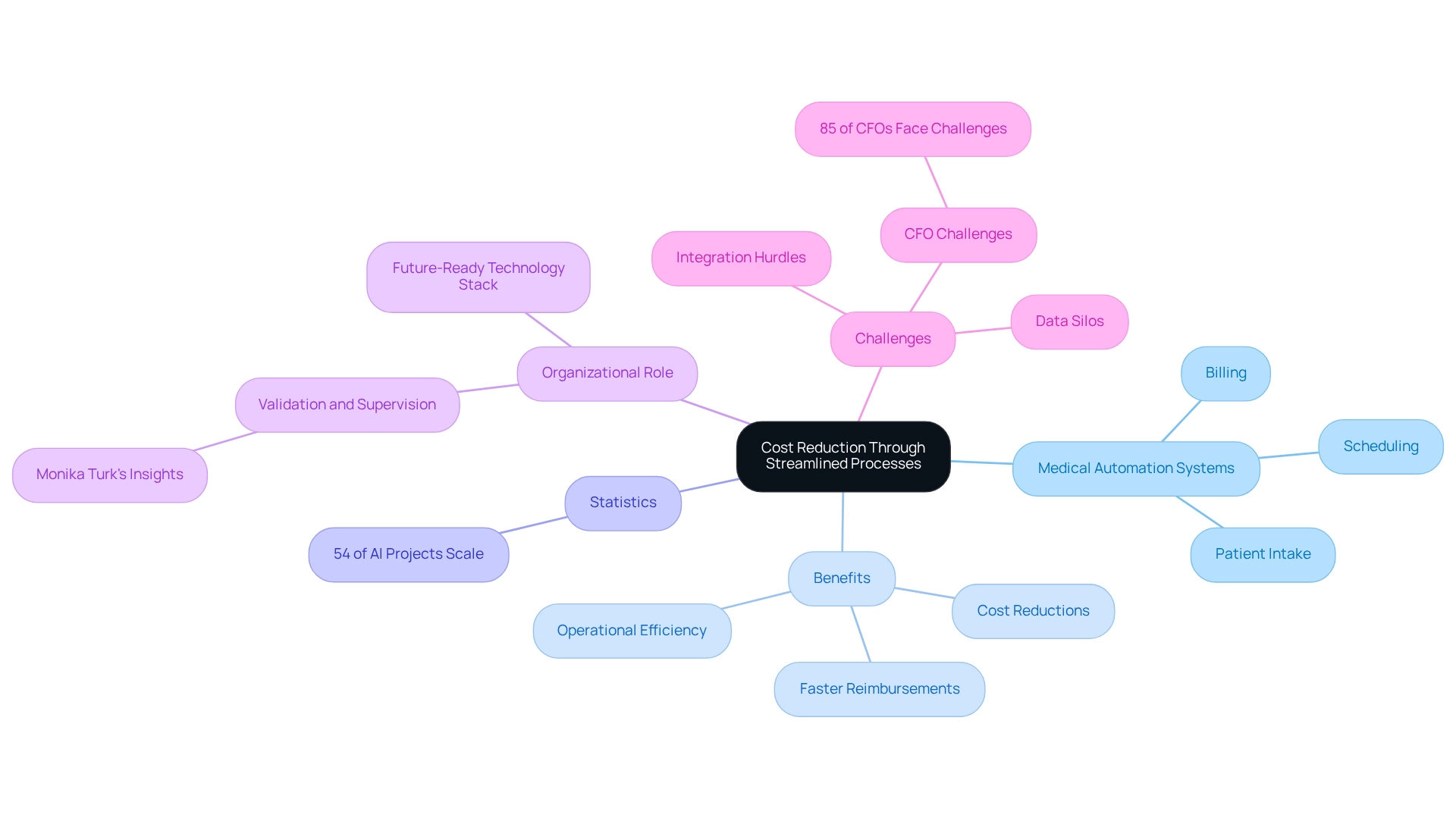
Increased Operational Efficiency and Resource Management
Medical automation systems play a pivotal role in enhancing operational efficiency within medical environments by significantly reducing the time spent on repetitive tasks. We see that medical automation systems, for instance, streamline appointment bookings, effectively minimizing gaps and maximizing client throughput. This optimization enables us to serve more individuals, thereby enhancing overall care delivery.
Furthermore, medical automation systems are essential for monitoring inventory levels and staff availability, ensuring that healthcare facilities operate smoothly. By mechanizing these processes with medical automation systems, we can uphold optimal operations, which not only improves healthcare but also increases staff satisfaction by reducing workload pressures.
The incorporation of digital medicine, especially through AI and VR technologies, further supports our efforts in utilizing medical automation systems. For instance, AI-driven solutions can provide personalized patient interactions, while VR can enhance treatment experiences, making care more humanized and effective.
The worldwide market for medical automation systems is anticipated to reach $39.49 billion by 2030, reflecting the rising acceptance of mechanization technologies in healthcare. This growth highlights our acknowledgment of technology’s value in enhancing operational efficiency.
Expert opinions indicate that surgical teams utilizing analytics-driven feedback have successfully reduced operation times by 20% while maintaining or even improving outcomes. This illustrates the potential of mechanization to not only streamline processes but also improve the quality of care delivered.
As the medical field continues to evolve, our integration of medical automation systems and digital innovations will be crucial in meeting the demands of modern patient care and achieving operational excellence.
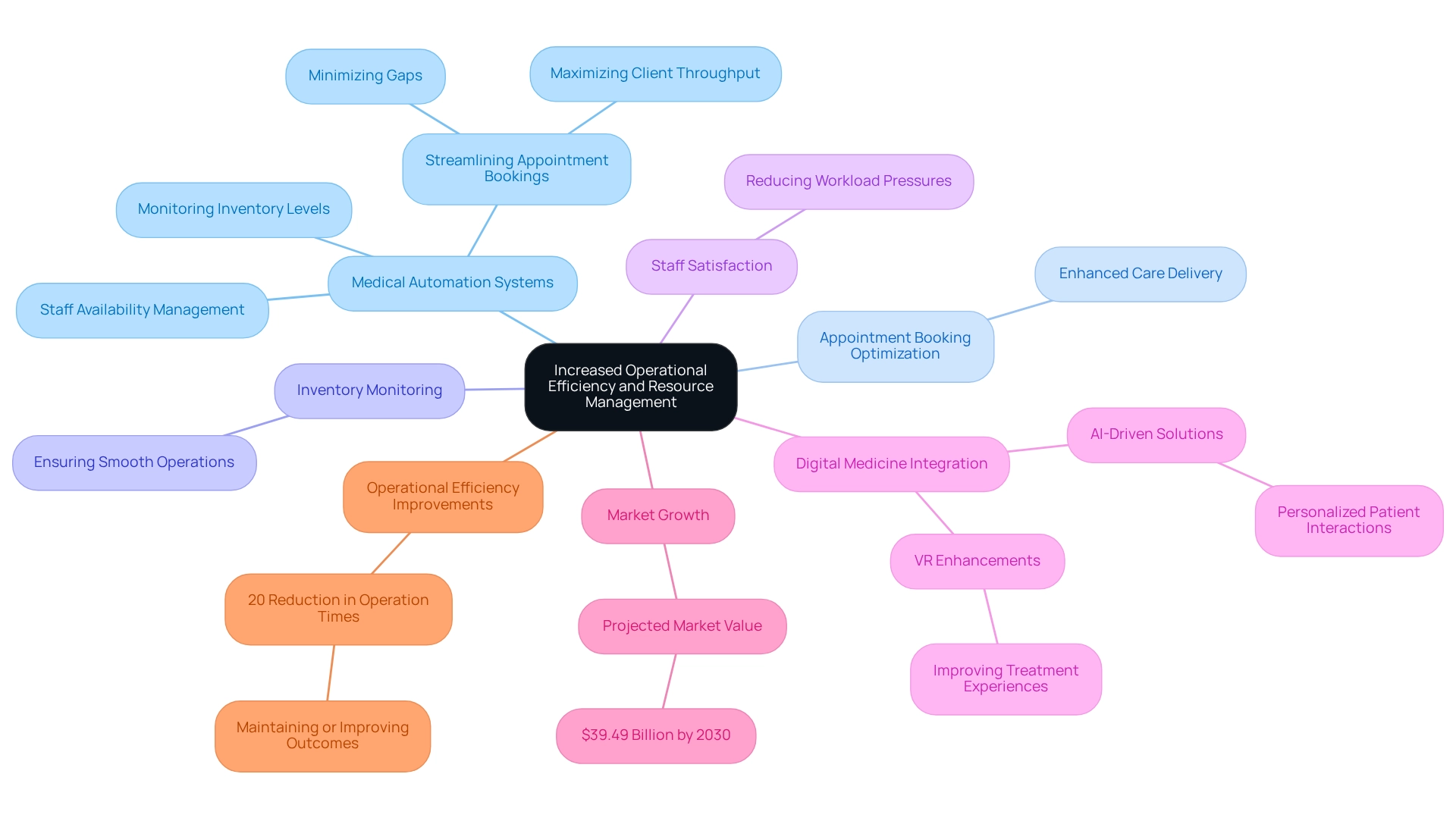
Enhanced Compliance with Healthcare Regulations
Medical organizations striving to maintain compliance with a multitude of regulations find that medical automation systems are essential. We recognize that medical automation systems adeptly monitor changes in medical regulations, ensuring our processes are consistently updated to reflect current requirements.
For instance, compliance management tools are specifically designed to securely handle patient data, thereby ensuring adherence to HIPAA regulations. By significantly reducing human errors and facilitating real-time observation, medical automation systems empower us to avoid costly penalties while maintaining high standards of care.
In fact, organizations that integrate compliance training with analytics have reported a 40% increase in understanding of compliance protocols, fostering a culture of accountability and transparency. Furthermore, 52% of compliance specialists assert that insufficient information regarding partners places companies at risk, underscoring the necessity for robust compliance management tools in the medical field.
As nearly one-third of businesses have encountered fraud or financial crime in recent years, the significance of medical automation systems as a preventive measure cannot be overstated. Our dedicated hybrid connection platform uniquely streamlines complex linkages, enabling us to enhance operational efficiency and tackle compliance challenges with greater confidence.
The platform’s capabilities facilitate seamless data integration and real-time updates, ensuring we can swiftly adapt to regulatory changes. As Gustavo Estrada noted, ‘Avato has the ability to simplify complex projects and deliver results within desired time frames and budget constraints,’ which highlights the effectiveness of automation in managing compliance challenges.
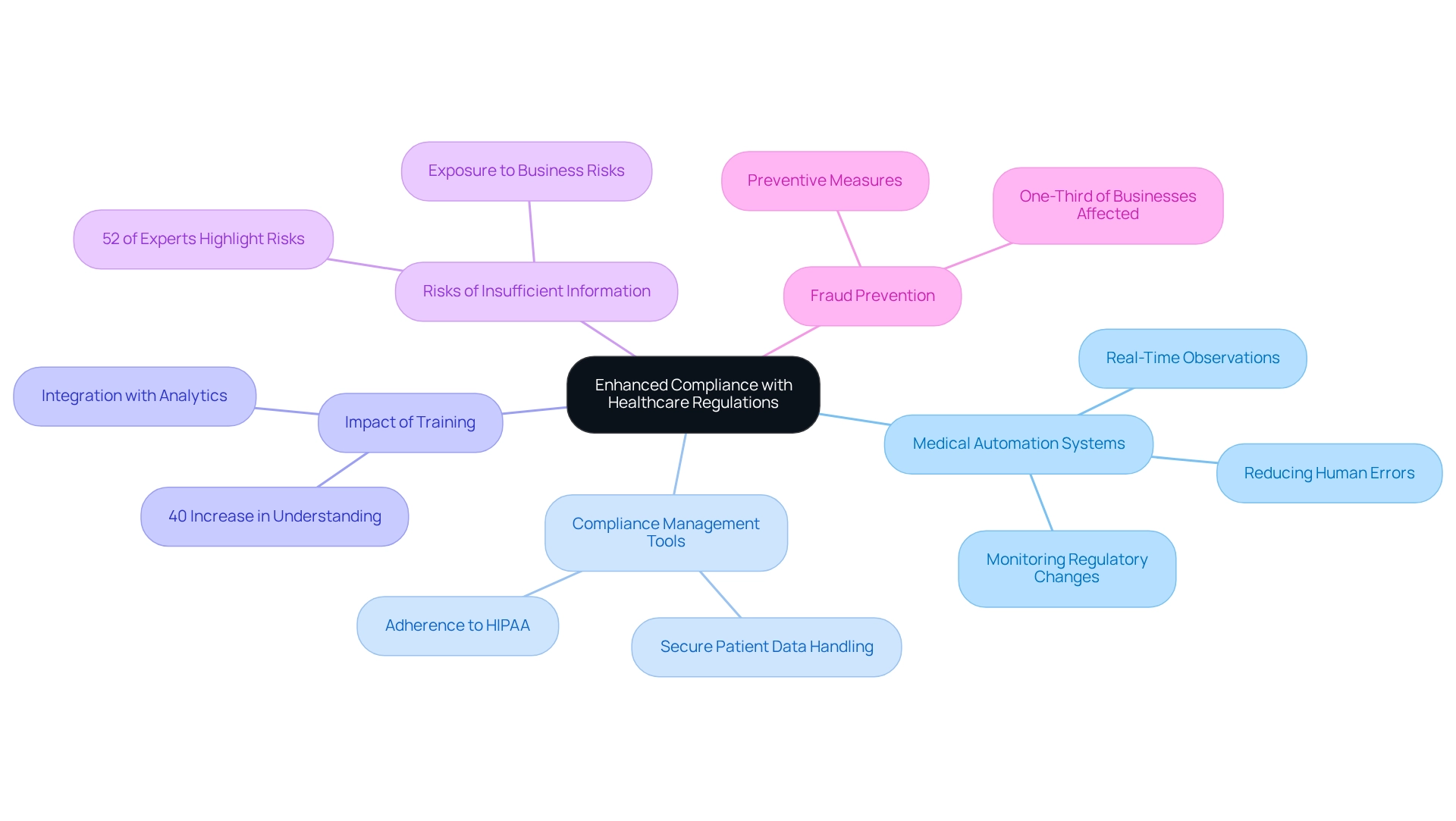
Improved Data Management and Decision-Making
Medical automation systems are revolutionizing the gathering, storage, and analysis of individual information, significantly enhancing the precision and dependability of medical data. By minimizing manual data entry, we drastically reduce errors, ensuring that medical providers have prompt access to accurate and up-to-date client information. This streamlined data management empowers clinicians to make informed decisions, as they can rely on comprehensive patient histories and advanced analytics to shape their treatment strategies. Furthermore, automated reporting tools generate actionable insights, enabling medical organizations to identify trends and elevate the quality of care provided.
As the medical technology market continues to expand—projected to grow from USD 35.2 billion in 2022 to USD 90.88 billion by 2032—the integration of these systems is becoming increasingly essential for efficient decision-making in medical environments. With Avato’s secure hybrid integration platform guaranteeing 24/7 uptime for critical integrations, we ensure that medical providers can depend on these automated systems to maintain operational continuity and reliability. Moreover, with 74% of existing AI users planning to boost their investments in automation over the next three years, the momentum towards automated data management is unmistakable, underscoring its vital role in contemporary medical operations. A robust sourcing strategy is also crucial for identifying valuable innovations in healthcare, positioning medical automation systems as a key component of a broader strategy for enhancing care delivery.
What’s holding your team back from harnessing these transformative solutions? Together, we can navigate the complexities of medical data management to deliver exceptional care.
Enhanced Patient Engagement and Communication
Automation significantly enhances user engagement by enabling timely and personalized communication. We can efficiently send appointment reminders, follow-up messages, and health tips directly to individuals through their preferred channels. This proactive communication approach not only keeps individuals informed but also empowers them to take an active role in their wellness journey. By promoting enhanced communication, we develop stronger connections with individuals, leading to greater satisfaction and improved health results.
Research shows that when both individuals receiving care and providers have access to shared analytics dashboards, satisfaction between them can increase by 31%. Our hybrid unification platform plays a crucial role in facilitating this by ensuring seamless data harmonization and analytics capabilities, which are essential for effective automated communication. With our commitment to streamlining intricate integrations, medical organizations can utilize these capabilities to improve their operational efficiency and interactions with individuals.
As Tony LeBlanc from the Provincial Health Services Authority states, “Good team. Good people to work with. Extremely professional. Extremely knowledgeable.” Moreover, the introduction of medical automation systems for communication has demonstrated an enhancement in engagement, with 80% of individuals expressing a preference for digital communication with their providers. These advancements highlight the transformative influence of medical automation systems in medical services, paving the way for improved experiences and outcomes for individuals.
Furthermore, the way ahead in medical services necessitates careful execution of analytics, concentrating on both technical skills and human elements to attain improved care for individuals.
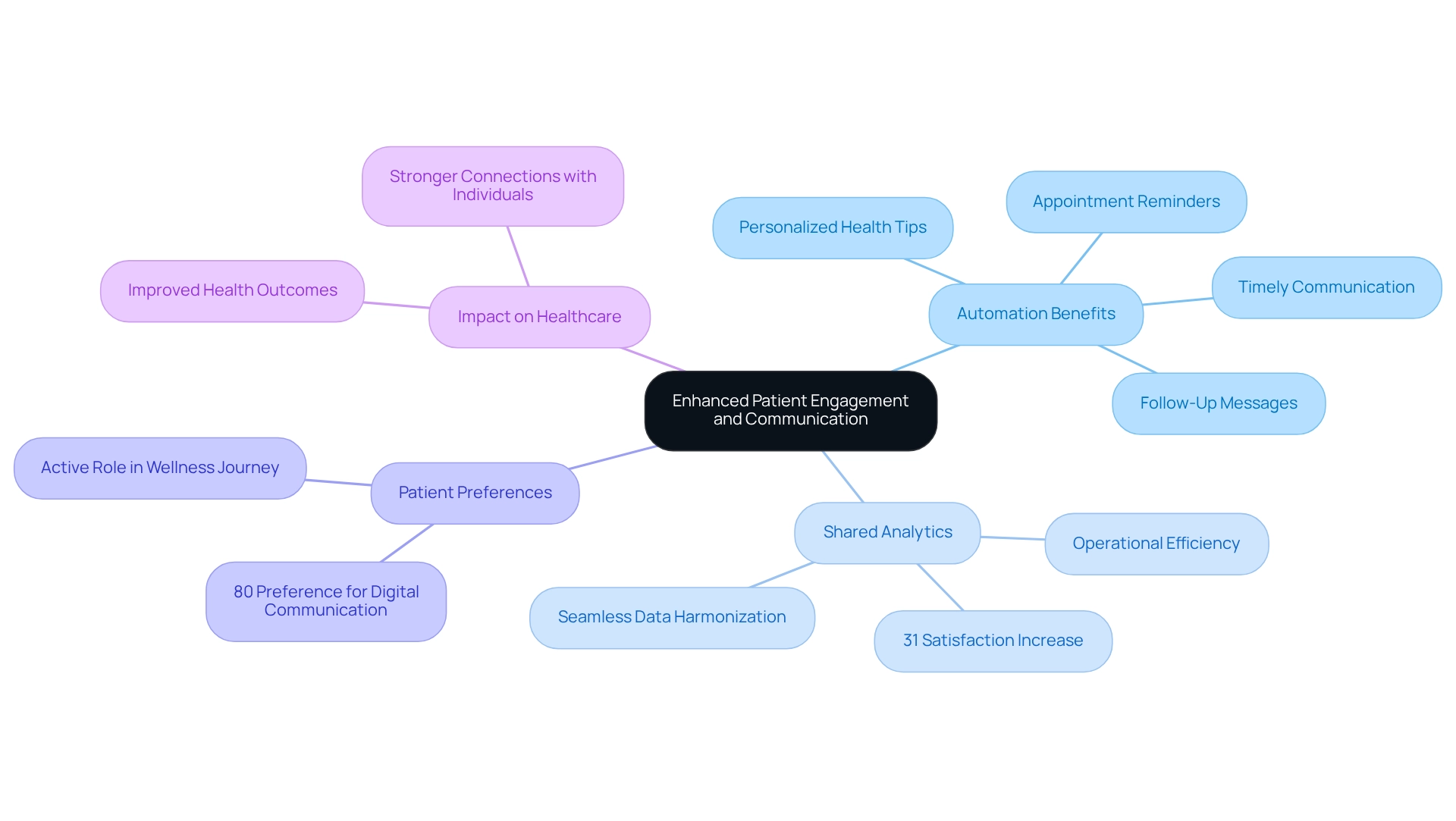
Reduced Administrative Burden on Healthcare Staff
The necessity of medical automation systems for automating routine administrative tasks in medical organizations can lead to a substantial reduction in staff workload. By utilizing medical automation systems for data entry, appointment scheduling, and billing, we can shift our attention toward client care. This shift alleviates the administrative burden while significantly enhancing job satisfaction among our staff. Research indicates that automation-driven predictive analytics can identify at-risk individuals, thereby reducing hospital readmissions and improving overall outcomes.
As healthcare providers gain more time for direct interactions with individuals, we can foster stronger relationships and deliver more personalized care. Effective case studies emphasize that organizations adopting medical automation systems have experienced enhanced efficiency, decreased staff burnout, and increased satisfaction among clients. Gustavo Estrada, a customer, noted, “Avato has the ability to simplify complex projects and deliver results within desired time frames and budget constraints,” underscoring the value of our hybrid integration platform in facilitating these automation processes.
To ensure a smooth transition to medical automation systems, we must invest in comprehensive training programs. This approach not only equips our staff with the necessary skills but also fosters a culture of innovation within our organization. Furthermore, it is crucial for medical organizations to maintain compliance with regulatory standards and conduct security audits to protect patient confidentiality, particularly in light of data security standards like HIPAA. Continuous research and case studies will assist us in navigating the complexities of contemporary environments as we adjust to technological changes. By strategically planning for medical automation systems and selecting appropriate solutions, we can effectively ensure that our staff feels supported and valued in their roles while minimizing administrative tasks and focusing on delivering high-quality care.
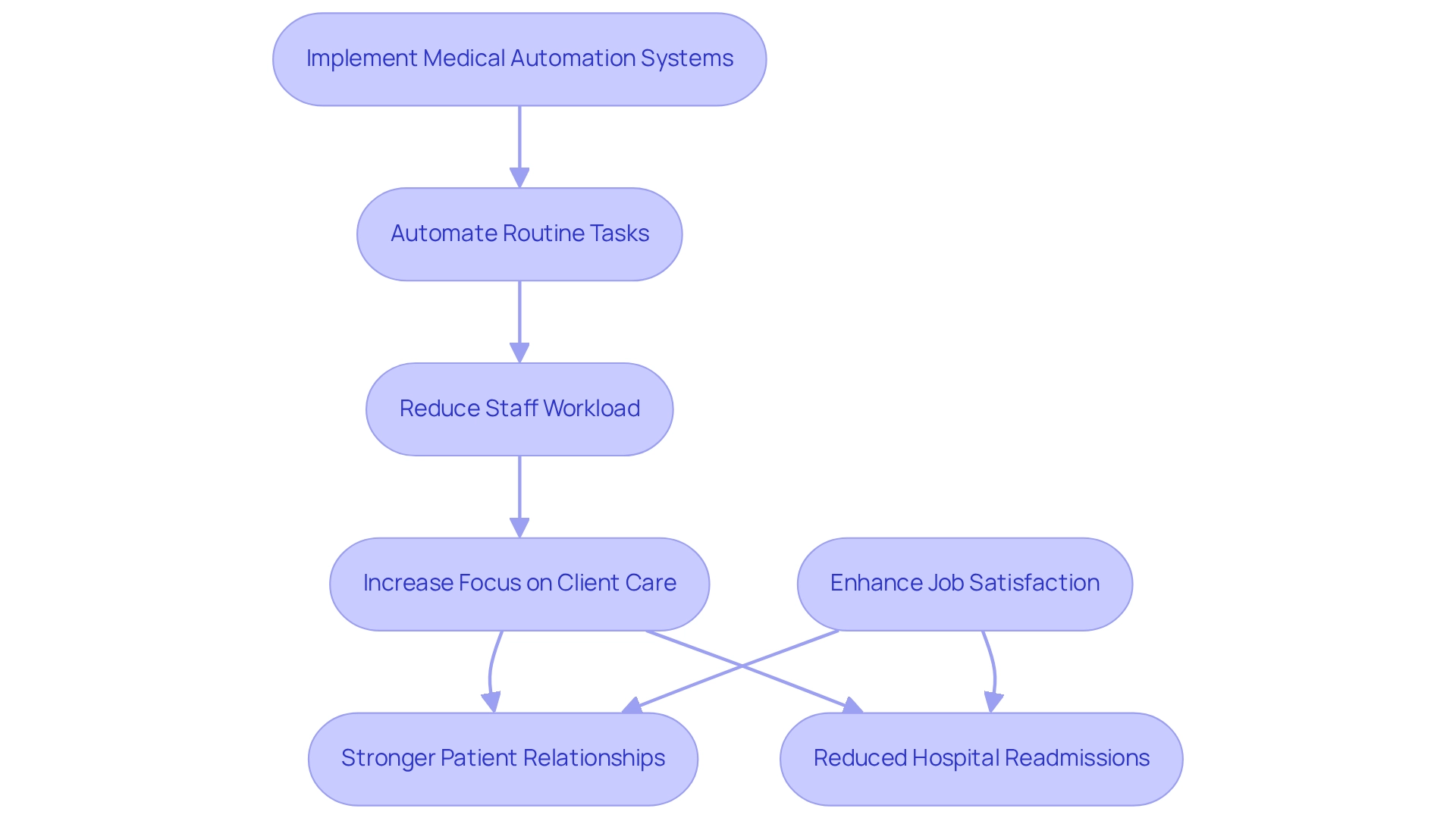
Better Resource Allocation and Management
Automation tools significantly enhance our resource allocation by delivering real-time insights into resource availability and utilization. For instance, medical automation systems can meticulously track inventory of medical supplies and promptly alert our staff when stock levels dip, effectively preventing shortages and minimizing waste.
Furthermore, advanced scheduling software enhances staff assignments according to client demand, ensuring our healthcare facilities are sufficiently staffed during peak times. This strategic improvement in resource management not only boosts operational efficiency but also elevates the quality of care we provide to patients.
In fact, automation has been shown to improve efficiency by 40-60% and reduce manual errors by up to 90%, delivering a return on investment in under 12 months. As Dr. Rebecca Martinez noted, “We’re witnessing a fundamental shift from compliance as documentation to compliance as demonstrable quality improvement—analytics is the bridge making this transition possible.”
Additionally, medical automation systems for equipment maintenance can improve equipment uptime by 20%. Our hybrid integration platform, featuring advanced transformation, routing, and aggregation, further enhances operational visibility, allowing us to quickly identify and resolve issues through its interactive dashboard.
As Kanwar Hayer, Project Manager at Provincial Health Services Authority, stated, “I love the visibility of what is going on. If there’s an issue, we know before it hits the operation so we can contain the issue.”
As we increasingly adopt these technologies, we can anticipate significant improvements in our operational capabilities and patient outcomes.
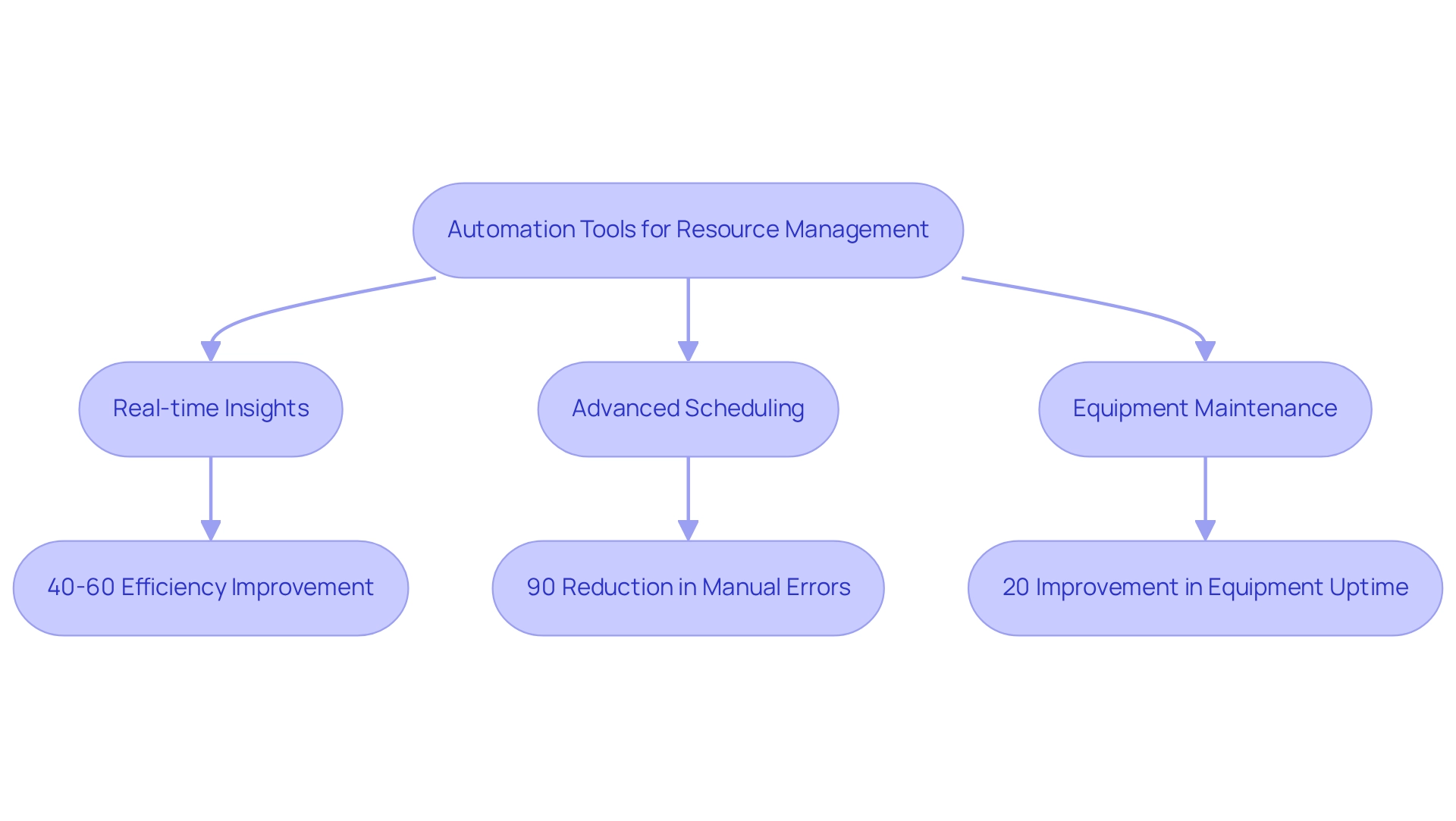
Driving Innovation in Healthcare Delivery
Medical automation systems are a pivotal force driving innovation in medical service delivery. By optimizing processes and enhancing data management with medical automation systems, we enable medical organizations to focus on developing new services and refining existing ones. Consider telehealth solutions that leverage technology, allowing individuals to receive care from a distance and significantly expanding the availability of medical services. In 2025, the latest advancements in telehealth technology highlight a surge in solutions that not only enhance user interactions but also improve operational efficiency.
Our committed hybrid unification platform is essential for simplifying diverse systems, allowing service providers to access isolated resources and elevate business value. This platform ensures seamless data transfer and unification across various medical applications, which is crucial for improving care quality and operational effectiveness. The integration of artificial intelligence and machine learning into medical processes is revolutionizing predictive analytics, enabling us to anticipate client needs and tailor our services accordingly. This transformation is exemplified by recent advancements in generative AI, which have redefined revenue cycle operations, addressing long-standing challenges and enhancing efficiency. A case study titled ‘Generative AI’s Impact on Revenue Cycle’ illustrates how these technologies are providing innovative solutions to persistent industry challenges.
Furthermore, the impact of telehealth solutions on patient access to care is profound, with medical automation systems playing a critical role in ensuring that medical services are not only accessible but also responsive to patient needs. AI is reshaping disease prevention by analyzing medical data to predict health risks before symptoms emerge, potentially reducing hospital admissions by over 50%. As banking IT managers contemplate the implications of automation in their own sector, the principles propelling healthcare innovation—especially through our integration solutions—can offer valuable insights into enhancing operational efficiencies and improving service delivery.
What’s holding your team back from leveraging these transformative solutions?
Conclusion
The integration of automation in healthcare is not merely a trend; it signifies a fundamental shift towards more efficient, accurate, and patient-centered care. By leveraging platforms like Avato’s hybrid integration technology, we can dismantle silos, enhance communication, and streamline operations—key elements in improving patient outcomes. The multifaceted benefits of automation extend from improved patient engagement and resource management to significant cost reductions and enhanced compliance with regulations.
As the healthcare landscape continues to evolve, the emphasis on real-time data and automated solutions becomes increasingly critical. These technologies not only assist in managing operational efficiency but also empower us to deliver personalized and timely care. By reducing administrative burdens, automating routine tasks, and enhancing data management, we can focus more on what truly matters: the health and well-being of our patients.
In conclusion, embracing automation is essential for healthcare organizations aiming to thrive in today’s fast-paced environment. The potential for innovation, improved patient experiences, and operational excellence is immense. As we invest in these transformative solutions, we set the stage for a future where quality care is accessible, efficient, and responsive to the needs of every patient. Now is the time for healthcare leaders to recognize the importance of these advancements and take decisive steps towards integrating automation into their operations for the betterment of all.

